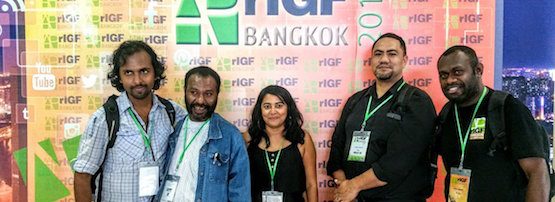
To develop awareness of the multistakeholder model of Internet governance and decision making among Pacific Small Island Developing States (SIDS), several government and not-for-profit organizations collaborated to host and organize the 2nd Pacific Internet Governance Forum earlier this year.
Adhering to the core IGF principles, the Pacific IGF was open and transparent, and used a number of inclusive approaches — including remote participation. This allowed as many stakeholders as possible to participate in the development of the program, and the forum itself. In total, 74 participants from 11 Pacific economies, including host economy Vanuatu, attended.
Read the report: 2017 Pacific Internet Governance Forum, Port Vila, Vanuatu
Participants shared their knowledge and best practices as they discussed the need to:
- Bridge the gap between ICT, agriculture, health, education, and environment.
- Extend awareness and understanding of the potential of ICT among national ministries.
- Continue these discussions so as to offer coordinated and considered recommendations at regional and global IGF discussions.
One such regional IGF is the Asia Pacific regional Internet Governance Forum (APrIGF), which I attended last month in Bangkok, in part because I’m a member of the organizing committee for APrIGF 2018, which will be held in Vanuatu, but also to report on and share the discussion points and recommendations from the Pacific IGF.
Interestingly, many of the themes that came out of our discussions at the Pacific IGF, held two months prior, were similar to those of APrIGF 2017, notably the need for greater accessibility to generate social and economic development.
Defining accessibility in the Pacific
Having had time to reflect on both forums, and the pursuing discussions, I’ve come to realize that “greater accessibility” can mean many things. It can refer to improved service and broader connectivity, cheaper Internet plans, new opportunities to access content, greater assistance for disabled users, and more secure access. And not just in reference to cybersecurity but also in terms of more resilient infrastructure to withstand natural risks, of which there are plenty in the Pacific.
“Connecting the unconnected” or “Connecting the next billion” are commonly used phrases in reference to improving Internet accessibility among least developed economies. It is difficult to not have a sceptical view of such vocabulary when many of these economies are struggling to access basic needs. Still, improved Internet access remains high on the agenda of many of these economies’ governments, including Pacific SIDS.
Internet penetration in the Pacific (excluding Australia and New Zealand) is around 20%, with mobile Internet being the most popular way for people to connect. Indeed, mobile technology and its ever-competitive market has had a positive impact in increasing the coverage of Internet access as well as decreasing the cost of access, particularly in economies where there are multiple mobile providers.
Still, Internet prices are among the highest in the world in these economies, with many providers reliant on expensive satellite connectivity. To alleviate this and, in the process improve connection speeds and provide redundancy, many Pacific economies are working on connecting to submarine cables — examples include the Fiji Connectivity Project and the Manatua Polynesian Cable.
Governments are also acutely aware that such enhanced infrastructure provides them with the opportunity to increase their own public accessibility through e-governance tools as well as the opportunity to enhance learning resources for their schools — the Vanuatu Telecommunications and Radiocommunications Regulator Community Learning and Information Centre (CLIC) project is just one example that was discussed during the Pacific IGF.
Likewise, they are aware of the need to improve awareness surrounding cybersecurity, develop policies, and establish national Computer Emergency Response Teams (CERTs) to assist in mitigating and responding to cybersecurity risks.
Whether these improvements can help meet many Island government’s policies and plans as well as the UN’s own Sustainable Development Goal for increased connectivity remains to be seen. But, as many in the region can attest, it’s a step in the right direction — one that will need patience, continued dialogue, and a well-coordinated multistakeholder approach.
Continuing the conversation at APrIGF 2018, Vanuatu
Vanuatu will be the host country for next year’s APrIGF, the first time the regional IGF will be hosted in the Pacific. It provides a fantastic platform to continue to build on the achievements at the recent Pacific IGF and APrIGF 2017, as well as the opportunity for key stakeholders in the Pacific to share their concerns and recommendations with regional partners.
In the lead-up to next year’s event, it’s hoped that recommended initiatives such as a multistakeholder advisory group/community and Pacific Islands Chapter of Internet Society (PICISOC) will continue governance discussions and look at pragmatic solutions for assisting with some of the ongoing challenges that have been reiterated in the above IG forums.
In my view, we need to ensure that everyone walks the talk and finds a way to work together to develop an agenda that will promote the role of Internet governance and ICT in the Pacific.
Stay tuned for more updates on APrIGF 2018.
Anju Mangal is a member of the Pacific Islands Chapter of Internet Society (PICISOC) and also part of the Pacific IGF organizing committee.
The views expressed by the authors of this blog are their own and do not necessarily reflect the views of APNIC. Please note a Code of Conduct applies to this blog.
